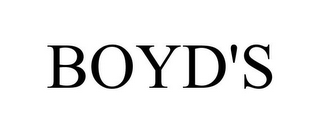 Boyd Coddington’s Hot Rods & Collectibles filed an application to register the trademark BOYD’S for apparel. But the USPTO examining attorney refused the registration based on a likelihood of confusion with the prior mark BOYDS for clothing. The TTAB affirmed the refusal finding the marks were virtually identical and the apostrophe was inconsequential in comparing the marks. Boyd Coddington’s Hot Rods & Collectibles, Inc., No. 78913114 (TTAB 2008).
Boyd Coddington’s Hot Rods & Collectibles filed an application to register the trademark BOYD’S for apparel. But the USPTO examining attorney refused the registration based on a likelihood of confusion with the prior mark BOYDS for clothing. The TTAB affirmed the refusal finding the marks were virtually identical and the apostrophe was inconsequential in comparing the marks. Boyd Coddington’s Hot Rods & Collectibles, Inc., No. 78913114 (TTAB 2008).
Similarly, Sears filed an application to register CROSS-OVER for bras. The USPTO Examining Attorney refused registration based on the mark CROSSOVER for ladies’ sportswear. The TTAB found that the marks were legally equivalent and the hyphen was of “no legal significance.” In re Sears, Roebuck & Co., 2 USPQ2d 1312 (TTAB 1987).
Simple punctuation alone usually does not distinguish marks because marks are compared in the following ways: (1) appearance, (2) sound, and (3) connotation. A similarity in any one of those aspects could be enough to find that the marks are similar. Many times you can’t hear punctuation when a mark is spoken, e.g. its sound. So, the punctuation is unlikely to distinguish the way the marks sound.
Looking at the Sears case, simple punctuation often doesn’t do much to distinguish the visual appearance of the marks either. Does CROSS-OVER appear much different from CROSSOVER to the average customer? Further, does the hyphen alone change the meaning of CROSSOVER? No, it does not.
While there might be some cases where punctuation could make a difference–possibly when combined with other distinguishing features–often punctuation alone does not do much to distinguish marks and avoid a conflict.